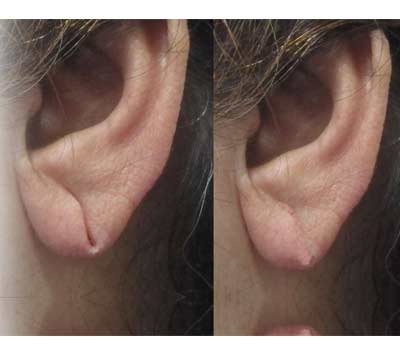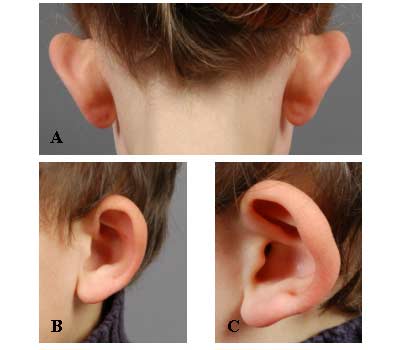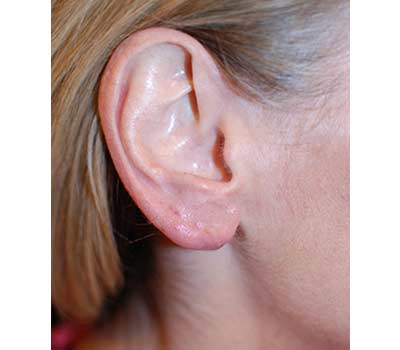 Torn earlobe , bifid lobe, or better known as torn ear, is most often caused by wearing heavy earrings, ear plugs or even by accident.
Torn earlobe , bifid lobe, or better known as torn ear, is most often caused by wearing heavy earrings, ear plugs or even by accident.
Surgery to repair a torn ear, known as lobuloplasty, is indicated for patients who wish to close the tear in the earlobe, or for those who do not yet have the tear, however the earlobe hole is enlarged.
It is also suitable for people who have already used plugs and currently no longer identify with the use of the accessory, feeling embarrassed with their torn ear.
After all, why can the ear tear?
The lobe, located in the lower region of the ear, is delicate. This is a region composed basically of fat and skin, with no muscles or cartilage to help support weights, factors that generate the risk of tears when wearing earrings and heavy hooks. Even so, individual predisposition is an important factor for the occurrence of tears and enlargement of holes in the ear. There are people who will develop the problem with lighter earrings, while others will have stronger earlobes and will support heavier earrings. That is, it is not entirely predictable who will or will not have problems with enlarged and torn holes. When in doubt, avoid wearing earrings that are too heavy, in order to minimize the risk.
The surgery
Lobuloplasty is considered a minor surgery, being done routinely in the doctor’s office.
In lobuloplasty, local anesthesia is performed on the lobe to be corrected, and only after a few minutes the surgery begins. In this way, the patient does not have any pain at the site to be operated on.
The edges of the ear tissue are then joined by sutures, with the aim of correcting the crack (tear) or reducing the hole.
It is important to point out that, even though it is small, lobuloplasty is a plastic surgery, and must be performed by an experienced professional and after a complete medical consultation, with preoperative exams to certify the patient’s health, if necessary.
Lobuloplasty is a generally quick surgery, lasting from 30 to 60 minutes (depending on the size of the tear and whether or not both ears need to be operated), and the patient can return home the same day, if she is in good health. conditions. After surgery, the patient goes home with a small dressing on the operated lobe, which may consist of Micropore adhesive tapes alone, or Micropore tapes with gauze, depending on the need to control postoperative bleeding. The surgeon will guide the care with each type of dressing, in each case. The patient will be instructed to take painkillers if she has pain and will eventually be given a prescription for post-operative antibiotics.
It is also possible to correct earring holes in other parts of the ear, such as the top of the ears and the tragus (the small bump that sticks to the skin of the head, just before the ear canal). However, these cases may eventually require slightly larger and more complex surgeries, as they are more delicate areas of the ear, made up of cartilage.
The postoperative
Surgery to correct a torn ear is considered a procedure whose postoperative period is practically painless and has a quick recovery. The patient can immediately return to their daily activities, not needing to rest.
In the first days after the surgery, there may be a slight swelling and local ecchymosis (purple), which usually subsides within 1 week. It is possible to disguise the dots and purple (if any) in the lobe with the use of skin-colored Micropore tape. In the first postoperative month, the patient is instructed to avoid direct exposure to the sun and use sunscreen.
The stitches are removed on average 10 days after surgery, with a good appearance at 2 weeks. The final result is only obtained, on average, after 3 months of surgery, when the scar is usually almost imperceptible.
It is possible to make a new hole in the operated lobe, if the patient wishes, but the scar line should be avoided, so as to reduce the chances of the lobe tearing again.
The risks
The general risks of all surgeries vary according to the specific characteristics of each patient, such as age, comorbidities (health problems), weight, smoking, medication use, genetic factors, among others. Therefore, they are explained in face-to-face consultation, due to the individual conditions of each one.
Complications and risks of the lobuloplasty procedure are rare, but the most relevant are poor healing, dehiscence, inflammation and infection.
Tips to prevent tearing and inflammation
– After lobuloplasty, the medical recommendation is not to put heavy earrings or plugs in the operated region, because there is a risk of the region tearing again, requiring a new corrective surgery.
– Do not drill holes – whether for earrings or plugs – or use pressure earrings on the surgery scar before the surgeon releases it.
– Follow the surgeon’s guidelines regarding care with dressings and cleaning of the ears in the postoperative period.
– Keep a correct follow-up with the surgeon during the postoperative period, to ensure that the result of the scars is as discreet and aesthetic as possible. Lobuloplasty scars usually evolve well, however, there is a chance of developing keloids (hard, raised pink scars) in the lobuloplasty incisions (especially in patients who have already had this problem in their own ear or in other parts of the body), which should be evaluated and treated by the plastic surgeon.







